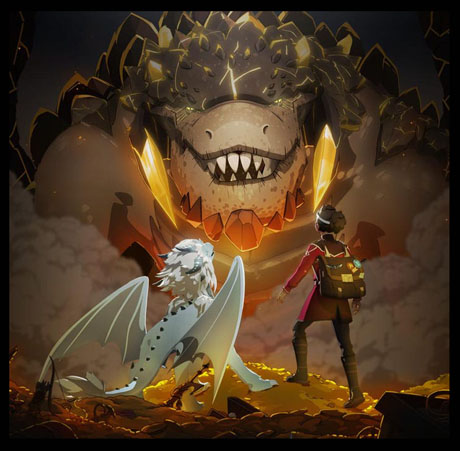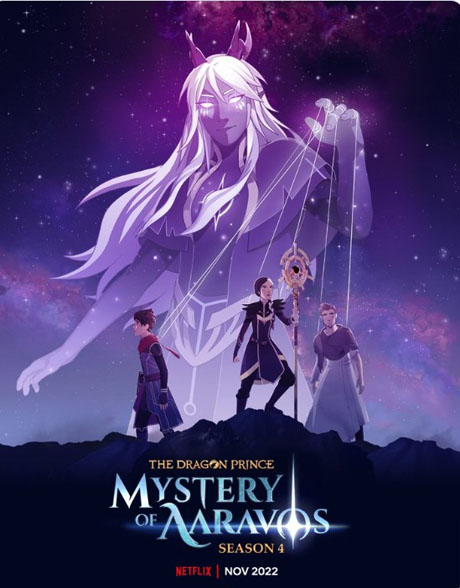
The Dragon Prince dodged a bullet.
Throughout the year, Netflix—the internet service that streams the epic fantasy—has engaged in drastic cutbacks in staff, and outright cancelled several animated projects, with the latest being Mike Judge’s Bad Crimes getting the axe midway through production. But the online network has spared The Dragon Prince. Why?

“There’s two answers,” says co-creator Aaron Ehasz. “One is just the structure of our partnership with Netflix. Wonderstorm is the studio and the structure of our contracts provides some stability for the show. And their commitment was for the full saga for seven seasons. The last reason is, the show is a hit. It’s doing well. It’s proven itself and is growing beyond expectations. And so that’s the show you keep making, because it thankfully has a very highly engaged audience and they’re a big audience.”
But in American animation, it’s unusual for a network to renew a show for four additional seasons in one order. What convinced Netflix to do that for The Dragon Prince?
“Justin’s very, very charismatic,” Ehasz says with a laugh.

Justin Richmond
From its beginning, Ehasz and Richmond envisioned the show to encompass seven seasons. There was no guarantee Netflix would renew the show after Season Three. Then to commit to four more seasons served as a big production advantage for Wonderstorm and its production partner, Bardel Entertainment.
“It’s always much easier,” Richmond says. “The more you know how much time you have ahead of time, the easier it is to write to that stack. [That level of] animation oftentimes is almost impossible to do season by season. It’s so much more expensive. So having all four is exactly what we asked for. It was great that we were able to go in and say, ‘Okay. Well, we know this much time and this many episodes, and so therefore we can write the story the way we want to and make it all work.’
“Two seasons would’ve been a satisfying package, even if we never got the next two. Whereas we could make four seasons meant to be watched together. That’s a huge win for us.”
The multi-season commitment gave the Wonderstorm team the creative latitude to plant seeds that would manifest themselves in later seasons.

“We’ve been doing that since Season One, even not knowing that,” Ehasz says. “The ability to plant things that might not seem as important or relevant to the overall big picture early, but then pay them off slowly and patiently, is really a cool part of epic storytelling. Being able to have four seasons allows you to do that with a lot of confidence because you know you’re gonna get those moments of revelation later.”
Ehasz had said, in our first interview, that “this is a show that rewards people who pay attention and care about the details”. These details become apparent upon repeat viewing—some intentional, some not. Such as the irony of Lord Viren massing an army of humans that he turns into monsters—for the sake of humanity.

Aaron Ehasz
An interesting parallel comes from Viren’s daughter, Claudia, who in the third season uses Dark Magic to heal her brother Soren, who was resigned to spending the rest of his life as a helpless cripple. Likewise in Season Four, Claudia uses Dark Magic to help her father, who had given up on life.
Ehasz notes, “We start to see character patterns—in this case, Claudia’s commitment to her family and her willingness to do anything to help them, even when it means sacrificing part of herself or doing something dark. It’s a consequence of following the characters in their patterns and repetitions and things that kind of harmonize in the universe, I think. Or maybe it’s just a coincidence.” He laughs.
But for Claudia to work her Dark Magic means sacrificing the lives of various creatures, including Bambi (actually, a nameless fawn). Do the show’s creators believe the ends justify the means?
“I don’t agree with that,” Ehasz says. “Fundamentally, I think are there times when there’s something unsavory about the means, but the ends are so important and so high value that you might be willing to do that to get there. I wouldn’t rule out that there are cases where some ends might justify some means. But in general, like the kind of blank cheque of the ends justify the means, I certainly don’t subscribe to that, personally.”
“Yeah, I agree,” Richmond says. “I would say no, I don’t agree with the ends justify the means. But it is nice to go like, ‘Okay, that one has fallen into that trap.’ It’s a nice piece of the job that you get to explore without having to face the real consequences of it.”
Ehasz adds, “There’s a continuum of that, right? I mean, I always feel like Dark Magic has parallels to things as small as eating meat. It’s like if you eat a cheeseburger. On some level, you think the ends of that cheeseburger justify some stuff that has happened in the world. I think everyone understands it on some level.
“It’s just, which means do they rule out and which means do they find acceptable to get to the ends they prefer or need?”

That brings us to the case of Sol Regem, the Sun Dragon, who hates humans because when they engage in Dark Magic, there’s a sacrifice of life. If Sol Regem eats vegetables or animals in his diet, he’s killing something as well. That makes Regem as guilty as the humans.
“That’s a really good point,” Ehasz says. “I’m sure he does eat meat, though. He has a notion of some hierarchy in the animal and beast kingdom, I think. He certainly eats meat. He’s not the great vegan Sun King, nope.”
With The Dragon Prince, Wonderstorm has expanded the franchise into novels, graphic novels, coloring books and role playing games. Some stories have been written that take place during the two-year gap between Seasons Three and Four, with one story laying the groundwork for Season Five.
Ehasz points out that the ancillary material is not necessary to enjoy Season Four because, “The series is written to be the prime storytelling delivery device. If you’ve just watched the series, there is enough information to follow that prime narrative.
“The other things [novels and short stories]—which are canon storytelling—give insight into the characters and their dilemmas and conflicts. Obviously Through the Moon is a canon story. It’s the graphic novel that takes place between Season Three and Season Four. And it explains Rayla’s absence, why she left, things like that.
“That’s a spoiler for Through the Moon, but not a spoiler for Season Four. But it’s also explained at the beginning of Season Four.”

Richmond says, “There’s also The Bloodmoon Huntress which just came out this summer. Which is not in between, but is certainly something that’s interesting going forward.”
“That sets up something in later seasons. Not in Season Four, but it does set something up in Season Five, to be honest,” Ehasz reveals.
Richmond says, “We also have that tabletop RPG, The Tales of Xadia. It has tons of information about the world of Xadia. There’s some story stuff in particular about what happened to Lux Aurea [the capital of the Sunfire Elves]. But there’s also tons more information about magical creatures and characters and dragons and all kinds of stuff. It’s fun to know, but you certainly don’t have to going into the next season.”
Wonderstorm also offers ten short stories, collectively called “Reflections,” posted on their website, www.thedragonprince.com. These are character vignettes between Seasons Three and Four, one of which features Soren inducting Corvus the tracker into the Crownguard (“Changing of the Guard”).
Ehasz points out, “There’s also one with Aaravos (“Patience”). There’s one with Callum finding the mirror (“Inheritance”). There’s one which is Rayla’s letter to Callum (“Dear Callum”). There’s one with Janai and Amaya (“Crackledrake”). There’s one with Ezran (“The Royal Council”). They’re wonderful short stories that connect to the characters.”
Notably, Netflix has decided to release all nine episodes of the fourth season, The Dragon Prince: Mystery of Aaravos, in one day, November 3, 2022. Why not release them one a week at a time as Disney+ and Amazon Prime does with their programming?
“I was hoping Netflix might consider an experiment with our show and try it that way,” Aaron Ehasz says. “It’s serialized and these exciting things happen week to week. Our fans are so engaged and they want to talk about it, and argue about it, and speculate about it. I would love to see something week to week or even in three parts or something like that. However, I think there’s also a notion at Netflix that they want to serve someone who would like to binge what they want when they want. Here it is, watch as much as you want right away. Be satisfied today.
“I certainly would like to see an experiment where we spread it out and had a period of conversation. But we’ll see. Maybe in a future season we’ll get to try something new.”
To be continued.
Special thanks to Jennifer Greene of Illuminate-Communications.
- INTERVIEW: Aaron Ehasz, Justin Richmond on “The Dragon Prince: Mystery of Aaravos”: The Right Choice for the Voice - March 20, 2024
- INTERVIEW: “The Dragon Prince” Influences, Inspirations, and the Mystery of Simpson - March 11, 2024
- INTERVIEW: The Magic of Her Voice: Paula Burrows of “The Dragon Prince” - October 4, 2023


 October 30th, 2022
October 30th, 2022  W.R. Miller
W.R. Miller  Posted in
Posted in  Tags:
Tags: 






